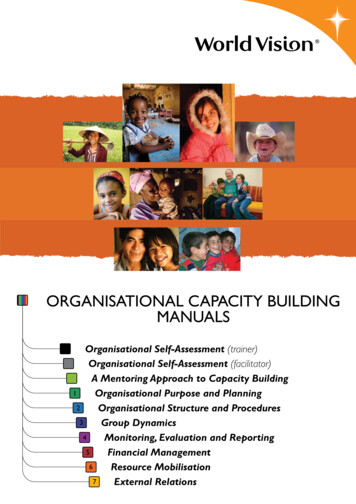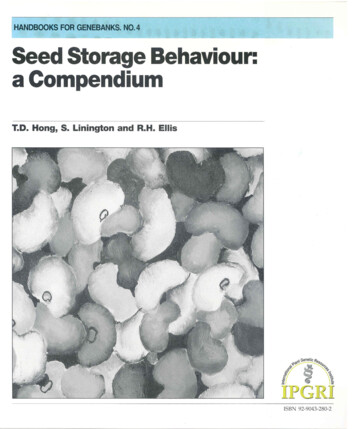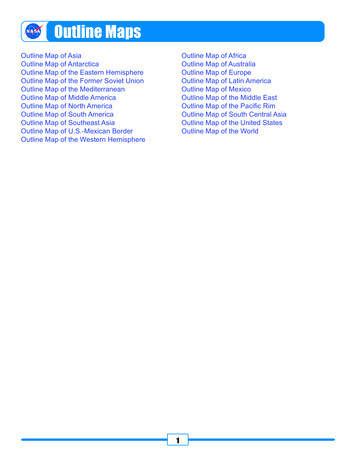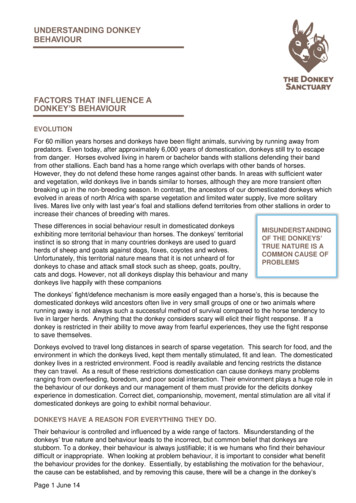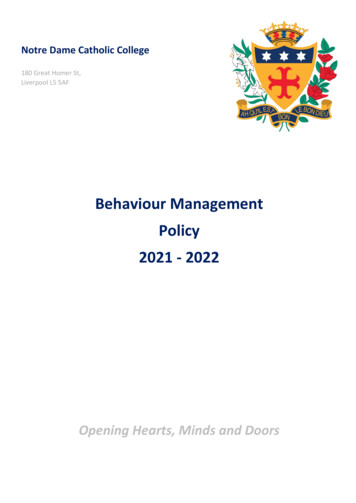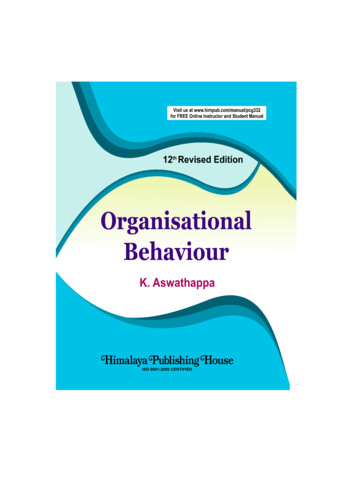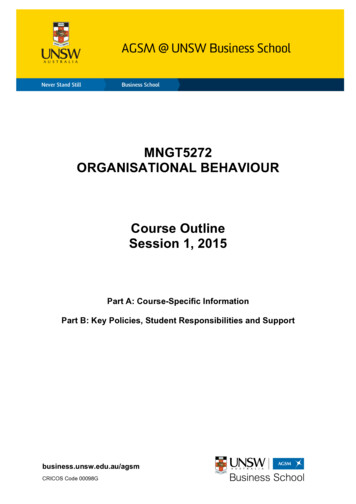
Transcription
AGSM @ UNSW Business SchoolMNGT5272ORGANISATIONAL BEHAVIOURCourse OutlineSession 1, 2015Part A: Course-Specific InformationPart B: Key Policies, Student Responsibilities and Supportbusiness.unsw.edu.au/agsmCRICOS Code 00098G
Table of Contents1STAFF CONTACT DETAILS12COURSE DETAILS12.1Teaching Times and Locations2.2Units of Credit2.3Summary of Course2.4Course Aims and Relationship to Other Courses2.5Student Learning Outcomes3LEARNING AND TEACHING ACTIVITIES3.1Approach to Learning and Teaching in the Course4ASSESSMENT111124444.1Formal Requirements4.2Assessment Details4.2.1Two Question Quizzes (9 in total)4554.2.2Course Citizenship Behaviours54.2.3Final Exam64.2.4Team: Three written cases.64.2.5Team: Presentation Battles84.2.6Team: Peer Evaluation84.3Assessment Format4.4Assignment Submission Procedure4.5Late Submission910105COURSE RESOURCES106COURSE EVALUATION AND DEVELOPMENT107COURSE SCHEDULE11PART B: KEY POLICIES, STUDENT RESPONSIBILITIES AND SUPPORT131PROGRAM LEARNING GOALS AND OUTCOMES132ACADEMIC HONESTY AND PLAGIARISM143STUDENT RESPONSIBILITIES AND CONDUCT153.1Workload3.2Attendance3.3General Conduct and Behaviour3.4Occupational Health and Safety3.5Keeping Informed15151516164SPECIAL CONSIDERATION AND SUPPLEMENTARY EXAMINATIONS165STUDENT RESOURCES AND SUPPORT17
PART A: COURSE-SPECIFIC INFORMATION1 STAFF CONTACT DETAILSLecturer-in-charge: Dr Will FelpsRoom: UNSW Business School - 576APhone No: 612 9385 8807Email: willfelps@gmail.comConsultation Times – by appointment by email2 COURSE DETAILS2.1Teaching Times and LocationsLectures start in Week 1 (to Week 12). The Time and Location are:Monday’s: 2:30-5:30pm [April 6th is a National Holiday]Place: Updated information about class times and locations can be found on theAGSM website and by logging in to the Google Calendar.2.2Units of CreditThe course is worth 6 units of credit.2.3Summary of CourseMNGT5272 provides you with an introduction to organisational behaviour (OB). Eachunit in this course covers a topic that contributes to your understanding of effectivemanagement and organising. Topics covered include: effective communication, hiring,negotiation, performance management, politics, change, organisational culture,organisational structure, and career management systems.2.4Course Aims and Relationship to Other CoursesThe course aims to: To improve your ability to interact with and manage people. To improve your ability to design effective organisations. To share helpful tactics for advancing your career.This course provides background knowledge that is relevant to several OB-relatedelective courses within the full-time MBA program, including MNGT5370 (LeadershipConcepts and Skills), MNGT5374 (Managerial Decision Making), and MNGT 5388(Negotiations and Strategy).MNGT5272 – Organisational Behaviour1
2.5Student Learning OutcomesBy the end of this course, you should be able to:1.2.3.4.Identify and evaluate OB challenges faced by managers.Define and explain key OB terms and concepts.Facilitate group discussions on issues relevant to organisational behaviour.Analyse workplace behaviours from one or more theoreticalperspectives/frames.5. Evaluate the usefulness of a range of ways of analysing organisationalproblems.6. Research and recommend solutions for key OB-related challenges managersface.MBA Program Graduate AttributesThis course contributes to your development of the following MBA Program GraduateAttributes, which are the qualities, skills and understandings we want you to have bythe completion of your degree:LearningOutcomes2,3,4,5,6.1,3,6.3, 6.1,2,3,4,5,6.3,6.MBA Program Graduate AttributesCritical thinking and problem solvingCommunicationTeamwork and leadershipIn-depth engagement with relevant disciplinaryknowledgeProfessional skillsMBA GA No.12356The Course Learning Outcomes are what you should be able to DO by the end of thiscourse if you participate fully in learning activities and successfully complete theassessment items.The Learning Outcomes in this course also help you to achieve some of the overallProgram Learning Goals and Outcomes for all undergraduate postgraduatecoursework students in the UNSW Business School. Program Learning Goals are whatwe want you to BE or HAVE by the time you successfully complete your degree (e.g.‘be an effective team player’). You demonstrate this by achieving specific ProgramLearning Outcomes - what you are able to DO by the end of your degree (e.g.‘participate collaboratively and responsibly in teams’).MNGT5272 – Organisational Behaviour2
MBA Program Learning Goals and OutcomesLearning Goal 1: Business Management KnowledgeStudents should be able to identify and apply current knowledge of disciplinary and interdisciplinarytheory and professional practice to general management and business within diverse situationsLearning Goal 2: Critical ThinkingStudents should understand and be able to identify, research and analyse complex issues andproblems in business and develop appropriate solutionsLearning Goal 3: CommunicationStudents should be able to produce written documents and oral presentations that communicateeffectively complex disciplinary ideas and information for the intended audience and purposeLearning Goal 4: TeamworkStudents should be able to participate collaboratively and responsibly in teams and to reflect upon theirown contribution to the team and on the necessary processes and knowledge within the team toachieve specified outcomesLearning Goal 5: Responsible BusinessStudents should be able to appraise ethical, environmental and sustainability considerations in decisionmaking and in practice in businessStudents should be able to consider the social and cultural implications of management practices andof business activitiesLearning Goal 6: LeadershipStudents should be able to reflect upon their own personal leadership style and the leadership needs ofbusiness and of teamsLearning Goal 7: International PerspectiveStudents should understand the needs of undertaking business within a global contextStudents should be able to apply business management knowledge to business situations within globalmarkets with due recognition for differences in cultural, legal, commercial and other issuesLearning Goal 8: Risk ManagementStudents should be able to demonstrate an understanding of the limits in precision and the risksassociated with business modelsStudents should be able to appraise risk and to develop risk mitigation strategies applicable tobusiness undertaken within uncertain and volatile environmentsFor more information on the Postgraduate Coursework Program Learning Goals andOutcomes, see Part B of the course outline.The following table shows how your Course Learning Outcomes relate to the overallProgram Learning Goals and Outcomes, and indicates where these are assessed (theymay also be practised in tutorials and other activities):MNGT5272 – Organisational Behaviour3
Program LearningGoals and OutcomesThis course helps you toachieve the followingMBA Program LearningGoalsCourse AssessmentItemCourse Learning OutcomesOn successful completion of thecourse, you should be able to:This learning outcome willbe assessed in thefollowing items:1BusinessManagementKnowledge understand how to manage moreeffectively.Final exam2Critical Thinking link concepts and practice.Cases3Communication present more effectively.Presentation Battles4Teamwork work in a team more effectively.Peer evaluation5ResponsibleBusinessNot specifically addressed in thiscourse’Not specifically addressedin this course’6Leadership influence others more effectively.Peer evaluation7InternationalPerspectiveNot specifically addressed in thiscourse’Not specifically addressedin this course’8Risk ManagementNot specifically addressed in thiscourse’Not specifically addressedin this course’3 LEARNING AND TEACHING ACTIVITIES3.1Approach to Learning and Teaching in the CourseThis course will utilize a blend of instructional methods and media to encourageboth an intellectual understanding and a personal sense of the subject matter.These will include lectures, readings, discussions, case studies, studentpresentations, films and experiential exercises. The goal will be to use class timeto maximum effect. Your contribution towards achieving this goal will be tocomplete the assigned readings and cases before each class and activelycontribute to each session.4 ASSESSMENT4.1Formal RequirementsIn order to pass this course, you must: achieve a composite mark of at least 50; and make a satisfactory attempt at all assessment tasks (see below).MNGT5272 – Organisational Behaviour4
4.2Assessment ssedLengthDue Date1, 2MBAGraduateAttributesassessed1, 5MC QuestionQuizzes (9 nal ExamBonus/Penalty4, 5, 61, 2, 5, 6N/AOngoing30%1, 21, 51.5 hrsTeam: Threewritten cases36%3, 4, 5, 61, 2, 3, 5, 67 pg maxWeek of s3, 4, 5, 61, 2, 3, 5, 625 minPerassignmentTeam: Peerevaluation16%3, 4, 5, 61, 2, 3, 5, 6N/ADue09-05-2015Total100%4.2.1 Two Question Quizzes (9 in total)On the majority of days, there will be a two-question quiz at the beginning of eachclass. The format will be multiple-choice and the questions will be drawn from: 1) thereading(s) (not cases) assigned for that day, and 2) the last lecture. In total, the quizzesare worth 18% of your grade. Your score will be a direct function of the percentagecorrect – i.e., if you get 70% correct, you get a 70 for this portion of your grade. Therewill be no makeups except for in extreme circumstances.If you feel there is a mistake with a quiz question, you are encouraged to submit awritten explanation of why you believe there was a mistake. This written appeal will beconsidered. If an error in the question is discovered, then all students’ grades will becorrected.In addition, to reduce the possibility of cheating, we will use a unique answer responseapproach that requires you to have the last number of your student ID memorized. So,please memorize your student ID prior to the first quiz.4.2.2 Course Citizenship BehavioursAttendance in every class is very important. If you do miss class, it is yourresponsibility to find out what was missed. In addition, it is very important that youcome to class ready to contribute your thoughts, impressions, and questions from thecases and readings to the class discussion. You are expected to be prepared for everyclass meeting. Since I frequently call on people whose hands are not raised, please letme know before the start of class if you are not prepared so that you are notinadvertently embarrassed. Note, however that this should only occur for exceptionalreasons. Importantly, what matters is the quality of your contributions more than theMNGT5272 – Organisational Behaviour5
quantity of contributions. At my discretion, one or two individuals per session may beawarded a bonus point of 1 on their final grade for (a) particularly insightful questionsduring presentations, (b) excellent contributions during discussion. Importantly, qualityis rewarded over quantity; and being a great citizen also entails knowing when not tospeak. Also, at my discretion, each class day I may penalize individuals, by subtracting1 point on their final grade for chatting with friends during class (although passingnotes is fine). You will know within a week if you have received such a penalty.4.2.3 Final Exam30 multiple-choice questions. The exam covers all content from the lectures andreadings, but not the cases. Your score will be a direct function of the percentagecorrect – i.e., if you get 70% correct, you get a 70.4.2.4 Team: Three written cases.You will be randomly assigned to one of ten teams for performing presentations andcase analyses. Each group will be required to prepare three written case analyses. Thecases are linked to through the syllabus.Each case should not exceed seven (7) double-spaced typed pages (2,5 cm, 12 pointfont, Times New Roman). This limit does not include appendices, which you are free touse for charts, figures, and other background material not necessary in the main bodyof your analysis. However, appendices which are not directly referenced in the maintext will not be read. For each case, submit through Turnitin sometime before class. Forsubmission instructions, please watch this video: hyperlink. Please do not write yournames on your case analysis. Identify yourselves only by your Student ID numbers.You should not discuss the case with any other groups.Your case analysis will be evaluated equally on the following six criteria:1) How well (i.e. thoroughly and concisely) you describe the organizational context,the relevant parties, and the factors that are important to the problem.2) Accurate and thorough use of course concepts from readings, discussions, andlectures.3) How well you integrate course concepts with information about the situation toilluminate the problem in a way that leads to solutions.4) Extent to which recommendations are consistent with analysis.5) Feasibility and specificity of recommendations.6) Quality of written analysis.General suggestions for cases:A classic structure for a case is to first (a) briefly describe the context, (b) analyze thekey issues in the case, (c) provide detailed recommendations for the case protagonistaddressing the urgent challenges described by the case, and (d) provide broaderrecommendations (e.g., which are either less urgent or are directed towards nonprotagonists). All of the cases in this class can be described as “problem solving” ratherthan “analysis based”. That is, the final goal is to justify a specific set of actions forparticular individuals. The readings and lectures should be employed to the extent thatthey help accomplish this goal.Despite the above, it is important to note that case solutions are “equifinal” – i.e.,different combinations of analysis and recommendations may be equally effective. Assuch, there is not one right answer.MNGT5272 – Organisational Behaviour6
So, while there is no simple formula for a strong case, below is some advice studentshave found helpful in the past.- Give yourself plenty of time to process the case by getting started as early aspossible.- Your analysis should not summarize the case in detail. I have read the case.Instead, use case facts to support your recommendations.- In the vast majority of cases, the readings are related to the cases – that is whythey were assigned together. Try to figure out the connection.- You should focus your analysis by applying the concepts from the course. While itis acceptable to incorporate several concepts from the course, please aim fromdepth rather than breadth.- Start by observing, even listing what is going on. You can safely assume that those“problems” you listed are really symptoms. Ask yourself: What is causing thesymptoms? Do some of the symptoms appear related?- Ask yourself: What are the rewards – both formal and informal – that are operatingin the situation?- Ask yourself: What are the good things going on you don’t want to disrupt or whichyou could use to your advantage in implementing a solution?- Ask yourself: What factors in the situation would be supportive of or facilitate thesuccess of your solution, and what obstacles might there be? (Think about theindividuals, the existing reward system, the organization structure, etc.)- Avoid making recommendations as if you were all-powerful and all-knowing.Instead, provide recommendations that the actors in the case could implementgiven resource constraints and political realities.- When thinking about the political dimension, ask yourself: Cui bono – i.e., “whobenefits?” From the status quo? From your proposed recommendations? These arepolitically important factors.- Ask yourself: Does your solution place too much reliance on other people being“reasonable” – i.e. on what you think is reasonable?- Ask yourself: Could your solution result in other problems? Is there adequate timeand money for your solution? What are the risks facing your solution? Can youplan around some? Do you need a backup plan – i.e., risk mitigation? Thinkthrough the implications of your analysis. Don’t end your analysis from A to B withB. What is likely to happen if B is or is not achieved? Recognize the inherenttradeoffs of any line of action.- In your solution, be specific about the actions that should be taken, rather thanrelying on broad prescriptions such as “stronger leadership,” “bettercommunication,” or “do more research.”- Outline your case solution before writing the text.- Think hard in advance about what you want to get out of these case analyses. Ifyou want to maximize learning and/or the final grade, my advice would be to haveeveryone involved somehow in each case. However, if you want to maximize thegrade to effort ratio, you might assign one or two people to do each case. Thatcould cut the work in half but decrease your grade by a much smaller factor. Thepoint is just to consider up front the tradeoffs associated with different groupprocesses. But please do not choose a work-intensive group process and thencomplain about workload.- Related to the last bullet, explicitly use the peer evaluations to make things fair andarbitrage across differences in utility profiles. If certain team-members don’t carevery much about their grades or have other obligations, they can let teammatesknow that it is fine if they are given a low mark on the peer evaluations. This willboost their teammate’s grades, since the peer evaluations are relative (see 4.2.6),and reduce interpersonal conflict.MNGT5272 – Organisational Behaviour7
4.2.5 Team: Presentation BattlesOn most days, there will also be a presentation competition on the case assigned forthat class. Teams are not required to prepare a written case analysis on the day(s) thatthey present.For the Presentation Battle, the procedure is that Group Y sits in the hall while Group Xpresents; then Group X sits out in the hall while Group Y presents (so neither teamgets to observe or ask questions of the other group). The presentations can last for upto 15 minutes. Then the class gets up to 10 minutes to ask questions of the group. Atleast three group members must somehow be involved in the presentation or questionanswering. After both teams have presented, the class does an anonymous vote. Theteam with the most votes wins. In the event of a tie, the instructor will break the tie.The members of the winning team get 2 on their final grade. There is no penalty forthe losing team.A piece of advice: practice the entire presentation as a group at least once beforeclass.4.2.6Team: Peer EvaluationAfter turning in the last case, you will be sent a link to a survey software, which will askyou a series of questions about the level of contribution made by team-members to thecases and presentation battles. The questions are provided below. 16% of teammembers’ grades for the course will be a function of these peer evaluations. Yourevaluations will be kept completely anonymous, although aggregate feedback will beprovided to each teammate. In terms of the peer evaluations are calculated, there areseveral steps. First, for each individual, I will sum their teammates’ ratings on the keydimensions associated with being an excellent teammate – i.e., contributing to theteam’s work; interacting with teammates; keeping the team on track; expecting quality;and having related knowledge, skills, and abilities. This score excludes self-ratings, soyour self-rating is irrelevant to your peer evaluation score. Next, using theseaggregated scores, I calculate the percentage above/below the average teammate inthe team. Thus, the peer evaluations are relative to other teammates. So, if there aremembers in the team who make really big contributions, that can cut into othermember's scores. However, the upside of being in a group full of strong teammates isthat your workload is lower and your team gets good evaluations on the cases. Next, Itake these relative percent above/below average scores and map it onto a grade. Inparticular, the average will be set to 70, and the percent above/below score will beadded/subtracted. Thus, someone who was rated as an average performer in the teamwould get a 70. Someone who was rated as performing 15% below average in theteam would get a 55 (70-15). Someone who was rated as performing 15% aboveaverage would get an 85 (70 15). That is the basics of how the peer evaluation scoreis reached. However, there are also a few more complicated tweaks I use to take intoaccount rating biases and any attempts to “game” the responses. Please rest assuredthat experience and rigorous research indicate that the final results are a fair reflectionof contributions made by each teammate.MNGT5272 – Organisational Behaviour8
4.3Assessment FormatFor general guidelines on formatting and presenting your assignment, resources/assessments-andexaminationsMNGT5272 – Organisational Behaviour9
4.4Assignment Submission ProcedureFor each case, submit through Turnitin sometime before class. For submissioninstructions, please watch this video: hyperlink.4.5Late SubmissionSince we will discuss case solutions in class, turning in team assignments late isunacceptable for this course.Refer to policy resources/assessments-andexaminationsQuality AssuranceThe UNSW Business School is actively monitoring student learning and quality ofthe student experience in all its programs. A random selection of completedassessment tasks may be used for quality assurance, such as to determine theextent to which program learning goals are being achieved. The information isrequired for accreditation purposes, and aggregated findings will be used to informchanges aimed at improving the quality of UNSW Business School programs. Allmaterial used for such processes will be treated as confidential and will not berelated to course grades.5 COURSE RESOURCESThe course website may be used for slides and some assessments. You canaccess Moodle using your student number and zPass by visiting:https://moodle.telt.unsw.edu.au/The readings for this course are available either through Moodle or hyperlinks inthis course outline.6 COURSE EVALUATION AND DEVELOPMENTMid- and end-of-Session feedback is sought from students about the courses offered inthe AGSM MBA Program, and continual improvements are made based on thisfeedback. The mid-Session feedback is collected in weeks 3 or 4, and communicatedto students in the class following its collection. Significant changes to courses andprograms within the Program based on end-of-Session feedback are communicated tosubsequent cohorts of students.MNGT5272 – Organisational Behaviour10
7 COURSE SCHEDULELecture Schedule: Lectures start in Week 1 and finish in Week 12.DAY 1 (09-02-2015): Introductiona. IN CLASS: auction; preview course; assign teams; crowd wisdom; sticky ideas.DAY 2 (16-02-2015): Leading Teams, Part one (guest lecture, Dr. Eliza Byington)a. READING: Felps, W., Mitchell, T. R., & Byington, E. (2006). How, when, andwhy bad apples spoil the barrel: Negative group members and dysfunctionalgroups. Research in Organizational Behavior, 27, 175-222. [Hyperlink]b. IN CLASS: Quiz 1, guest lecturec. DUE: NothingDAY 3 (23-02-2015): Leading Teams, Part twoa. READING: Polzer, J. T. 2003. Leading teams. Harvard Background Note,#403094-PDF-ENG.b. IN CLASS: Quiz 2, Harvard Simulation: Leadership and Team Simulation:Everest V2. Product #: 7000-HTM-ENGc. DUE: NothingDAY 4: (02-03-2015): Hiringa. CASE: Groysberg, B., Balog, S., & Haimson, J. (2007). Recruitment of a star.HBS: 407036-PDF-ENG.b. READING: Fernández-Aráoz, C., Groysberg, B., & Nohria, N. (2009). Thedefinitive guide to recruiting in good times and bad. Harvard Business Review,87(5), 74-84.c. IN CLASS: Quiz 3; Presentation Battle (T1 & T2); Discuss case; Lecture onhiring.d. DUE: First case analysis due for teams not presenting; Send Dr. Felps a recentcopy of your resume (willfelps@gmail.com)DAY 5 (09-03-2015): Resumes & Interviewing (guest lecture; Robyn Gleeson andBarbara Mackie from Career Development Centre)a. READING: Higgins, M. 2004. Note on Interviewing. Harvard Background Note.405014-PDF-ENG.b. IN CLASS: guest lecturec. DUE: Bring a copy of your resume to class.DAY 6 (16-03-2015): Negotiation & Landing a Joba. CASE: Sebenius, J. K. (1999). Doyle's dealmaking dilemma: Negotiating the jobsearch. HBS Case: 800124-PDF-ENG.b. READING: Types of Negotiation: Many Paths to a Deal. Harvard BusinessPress Chapters. Product #:5641BC-PDF-ENG]c. IN CLASS: Quiz 4; Presentation Battle (T3 & T4), Case analysis; Negotiationlecture; Practice negotiatingd. DUE: Second case analysis due for teams not presenting.MNGT5272 – Organisational Behaviour11
DAY 7 (23-03-2015): Performance, Project, (and potentially meeting) Managementa. CASE: Collins, E., & Greiner, L. E. (2008). A day in the life of Alex Sander:driving in the fast lane at Landon Care Products. HBS Brief Cases. Productnumber: 2177-PDF-ENG.b. READING: Gabarro, J. J., & Hill, L. A. (1995/2002). Managing performance.Industry and background note. HBS: 496022-PDF-ENGc. IN CLASS: Quiz 5; Presentation Battle (T5 & T6), Case analysis; Lectured. DUE: Third case analysis due for teams not presenting.DAY 8 (30-03-2015): Power, Politics, and Social influencea. CASE: Sasser, W. E., & Beckman, H. (2008). Thomas Green: Power, officepolitics, and a career in crisis. HBS Brief Cases: # 2095-PDF-ENG.b. READING: Dillon, K. (2013). HBR Guide to office politics. Harvard BusinessPress Books. 16547-PDF-ENG. ONLY Section 1 (pg. 1-36)c. IN CLASS: Quiz 6; Presentation Battle (T7 & T8), case discussion, Lectured. DUE: Fourth case analysis due for teams not presenting.DAY 9 (06-04-2015): National Holiday!DAY 10 (13-04-2015): Helpfulnessa. READINGS: Grant, A. M. 2013. In the company of givers and takers. HarvardBusiness Review, April, Product #:R1304G-PDF-ENG.b. IN CLASS: Quiz 7, How to be helpfulDAY 11 (20-04-2015): Organisational culture (guest lecture by Dr. Julie Cogin)a. READINGS: Chatman, J., & Cha, S. E. 2003. Leading by leveraging culture.California Management Review. 45(4), 20-34. [Hyperlink]b. IN CLASS: Quiz 8DAY 12 (27-04-2015): Organisational Change & Synthesis (going until 6pm)a. READINGS:i. Beer, M., & Nohria, N. (2000). Cracking the code of change. HarvardBusiness Review, May/June: 133-141.ii. Kotter, J. P. (1995/2007). Leading change: Why transformation efforts fail(HBR Classic), Harvard Business Review, R0701J-PDF-ENG.b. IN CLASS: Quiz 9; Harvard Simulation. Change Management Simulation:Power and Influence.c. DUE: Bring at least one ipad per team to classFINAL EXAM: Wednesday, Week of May 4th; Room: JBR; Details TBDMNGT5272 – Organisational Behaviour12
PART B: KEY POLICIES, STUDENT RESPONSIBILITIES ANDSUPPORT1 PROGRAM LEARNING GOALS AND OUTCOMESThe UNSW Business School Program Learning Goals reflect what we want all studentsto BE or HAVE by the time they successfully complete their degree, regardless of theirindividual majors or specialisations. For example, we want all our graduates to HAVE ahigh level of business knowledge, and a sound awareness of ethical, social, culturaland environmental implications of business. As well, we want all our graduates to BEeffective problem-solvers, communicators and team participants. These are our overalllearning goals for you.You can demonstrate your achievement of these goals by the specific outcomes youachieve by the end of your degree (e.g. be able to analyse and research businessproblems and propose well-justified solutions). Each course contributes to yourdevelopment of two or more program learning goals/outcomes by providingopportunities for you to practise these skills and to be assessed and receive feedback.Program Learning Goals for undergraduate and postgraduate students cover the samekey areas (application of business knowledge, critical thinking, communication andteamwork, ethical, social and environmental responsibility), which are key goals for allASB students and essential for success in a globalised world. However, the specificoutcomes reflect different expectations for these levels of study.We strongly advise you to choose a range of courses which assist your development ofthese skills, e.g., courses assessing written and oral communication skills, and to keepa record of your achievements against the Program Learning Goals as part of yourportfolio.MNGT5272 – Organisational Behaviour13
MBA Program Learning Goals and OutcomesLearning Goal 1: Business Management KnowledgeStudents should be able to identify and apply current knowledge of disciplinary and interdisciplinary theoryand professional practice to general management and business within diverse situationsLearning Goal 2: Critical ThinkingStudents should understand and be able to identify, research and analyse complex issues and problemsin business and develop appropriate solutionsLearning Goal 3: CommunicationStudents should be able to produce written documents and oral presentations that communicateeffectively complex disciplinary ideas and information for the intended audience and purposeLearning Goal 4: TeamworkStudents should be able to participate collaboratively and responsibly in teams and to reflect upon theirown contribution to the team and on the necessary processes and knowledge within the team to achievespecified outcomesLearning Goal 5: Responsible BusinessStudents should be able to appraise ethical, environmental and sustainability considerations in decisionmaking and in practice in businessStudents should be able to consider the social and cultural implications of management practices and ofbusiness activitiesLearning Goal 6: LeadershipStudents should be able to reflect upon their own personal leadership style and the leadership
COURSE DETAILS 1! 2.1!Teaching Times and Locations 1! 2.2!Units of Credit 1! 2.3!Summary of Course 1! 2.4!Course Aims and Relationship to Other Courses 1! 2.5!Student Learning Outcomes 2! 3!LEARNING AND TEACHING ACTIVITIES 4! 3.1!Approach to Learning and Teaching in the Course 4! 4!ASSESSMENT 4! 4.1!Formal Requirements 4! 4.2!Assessment Details 5!

